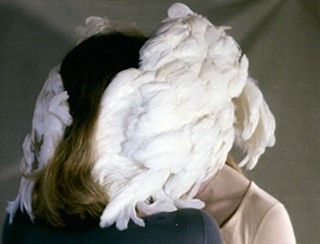The German artist who revolutionised film and performance art with her defiant and whimsical body extensions is the subject of a new Tate Modern display this June
Who? German artist Rebecca Horn was born a year before the end of the Second World War, and as such her first encounter with drawing, which came about through her Romanian nanny, introduced her to a new language that was free from burden. “We could not speak German,” Horn has previously said of her childhood. “Germans were hated. We were always travelling somewhere else, speaking something else. I could just draw”. Years on from that first introduction to her form, Horn is less known now for her works on paper than for those which tread the fine line between performance and installation art – ultimately erotic and deeply visceral pieces.

Throughout her life she has maintained a nomadic status, living wherever her work takes her. “If a country asks me to make a piece for them, I go and live there,” she has said – and so it was during a stint in a pay-by-the-hour hotel in Barcelona during the 1960s that changed the nature of her art forever. The artist was working with fibreglass at the time, unprotected in the confines of her transient home, and the material poisoned her lungs. It was during the year-long recuperation in a sanatorium which followed that Horn metamorphosed, with all of the cocoon-like imagery the word implies, into the artist she is today.
Physical isolation and loneliness have been manifested in her work ever since: from her hospital bed she could stitch and sew, and did so to create the first pieces that would connect the body to her surrounding environment, just out of reach. Extensions of the body have remained a prevalent theme in Horn's work ever since, each creating an intimate separation between the performer and their world.

What? Horn’s work is replete with singularly beautiful imagery. Einhorn, 1970-72, perhaps the artist’s most frequently referenced work, is an invocation of the unicorn, a medieval symbol of purity, chastity and innocence. It is a sculptural garment, a 'body extension' which transforms its wearer into a performer; a white horn pointing towards the sky is placed atop her head and attached, bandage-like, to her naked body. As in a trance, she walks through fields of wheat, the sheaves brushing against her hips towards the rising sun.
Similarly, in her 1972 work White Body Fan, the body is again recalled as part-human, part-other. A series of elaborate strings and pulleys create the illusion of the possibility of flight, as if the performer were both woman and bird. From these body extensions followed the kinetic sculpture, automata (or installation machines) and filmmaking. The Feathered Prison Fan, as featured in the 1978 film Die Eintänzer is a sublime, veiled enclosure of feathers encasing the body from the outside world in a most romantic shell-like hold, while her automata liberate inanimate objects to create spectacularly eerie and poignant moments. The Tower of the Nameless, staged in Vienna in 1994 as an ode to refugees from the Balkan states, was a tower of mechanically playing violins. Concert for Anarchy, created in the 1970s, and later in the 90s, saw dancing tables, a suitcase attempting to climb a pole, and hammers pecking at their own reflections. A piano hangs from the ceiling releasing a cacophonous clatter, before spewing its contents and retracting them again in a violent subversion.

Why? Considering the cultural relevance of Horn's artistic output, it's unsurprising that Tate Modern has chosen to highlight her oeuvre this season, with both a weekend-long celebration of her incredible archive of performance films, and a retrospective display of her body sculptures, performance documentation and works on paper, which is due to go on show in the Tate's new space this June. These pieces are utterly fascinating. From the Pencil Mask of the 1970s – a bondage-like black leather mask furnished with two-inch pencils (the performer creates an actual physical imprint of their place in their world by moving backwards and forwards across a wall, in a claustrophobic and immediate expression) – to the unicorn walking into a resplendent German forest, Horn's performance of the body represents the sublime with a magician-like quality.
Rebecca Horn: Films, 1970-2016 ran from May 6-8, 2016 at Tate Modern. A retrospective display of Rebecca Horn’s work will open in June at Tate Modern’s new Switch House building.
